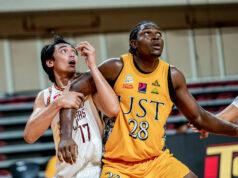The 13th Asian Schools Chess Championship 2017 was held in Panjin City, China from July 20-30, 2017. Panjin is a prefecture-level city and a major oil production center of Liaoning province, People’s Republic of China. This is in Northeastern China, part of what used to be called Manchuria.
There were competitions in six (6) Age Groups (Under 7, Under 9, Under 11, Under 13, Under 15 and Under 17) in two (2) divisions (open and girls-only) and in three (3) time controls: standard (90 minutes play-to-finish with 30 seconds additional after every move starting move 1), rapid (15 minutes play-to-finish with five seconds additional after every move starting move 1) and blitz (3 minutes play-to-finish with two seconds additional after every move starting move 1).
Whew! That makes a total of 36 independent tournaments involving several hundred players all of which is to finish in 10 days, with 36 gold medals, 36 silvers and 36 bronze to be awarded.
The Philippine delegation was led by Head Coach GM Eugenio Torre, Coaches (both National Masters) Cesar Caturla and Roel Abelgas, ably assisted by Mrs. Brigida Palasigue and Mr. Delio dela Cruz. We sent seven boys and five girls to compete in 11 categories out of 12. We had no player in the Under 7 Girls category but had 2 players in the Under 9 Open category.
After the smoke of competition had settled the Philippine Schools Chess Team captured 7 Golds, 10 Silvers, 1 Bronze to place 3rd overall out of 22 participating nations. China got 10 Golds, 7 Silvers, 10 Bronzes to take 1st place overall and Uzbekistan took 2nd place by snatching 8 Golds, 6 Silvers and 4 Bronzes.
Gold medalists:
Under 7 Open Rapid — Al-Basher Buto
Under 7 Open Blitz — Al-Basher Buto
Under 13 Open Blitz — Daniel Quizon
Under 13 Girls Rapid — Jerlyn Mae San Diego
Under 13 Girls Blitz — Jerlyn Mae San Diego
Under 17 Girls Standard — WFM Allaney Jia Doroy
Under 17 Girls Rapid — WFM Allaney Jia Doroy
Silver medalists:
Under 9 Girls Standard — Daren Dela Cruz
Under 11 Open Blitz — Jerish John Velarde
Under 13 Open Rapid — Daniel Quizon
Under 15 Girls Standard — Kylen Joy Mordido
Under 15 Girls Rapid — Kylen Joy Mordido
Under 15 Girls Blitz — Kylen Joy Mordido
Under 17 Open Standard — CM Stephen Rome Pangilinan
Under 17 Open Rapid — CM Stephen Rome Pangilinan
Under 17 Open Blitz — CM Stephen Rome Pangilinan
Under 17 Girls Blitz — WFM Allaney Jia Doroy
Bronze medalist:
Under 15 Open Rapid — Gal Brien Palasigue
There was a bit of controversy as the organizers had announced that winners of the Under-13, Under-15 and Under-17 categories shall be awarded the FIDE Master (FM) or Woman’s FIDE Master (WFM) title. The Silver & Bronze Medal winners shall be awarded the Candidate Master (CM) or the Woman’s Candidate Master (WCM) title.
For Under-7, Under-9 and Under 11 categories, medalists (gold silver and bronze) will be awarded the Candidate Master (CM) or Woman Candidate Master (WCM) title.
It seems that in the meantime the new FIDE title regulations took effect as of July 1, 2017 and it specified that for direct titles to be awarded immediately an applicant has to have achieved at some time or other a minimum rating as follows:
Grandmaster (GM) 2300
International Master (IM) 2200
FIDE Master (FM) 2100
Candidate Master (CM) 2000
Woman Grandmaster (WGM) 2100
Woman Master (WIM) 2000
Woman FIDE Master (WFM) 1900
Woman Candidate Master (WCM) 1800
So, our gold medalists (in the standard, of course — there are officially no titles yet specific for rapid or blitz) can be awarded their new titles, but only provisionally, and they will receive the full titles only upon reaching the required rating.
With two golds and one silver out of three tournaments Woman’s FIDE Master (WFM) Allaney Jia Doroy, a 15-year-old girl from Agusan del Sur, was our most bemedalled player. She is a Grade 10 student at Nazareth School of National University. This is a good recovery from the East Asian Juniors Tournament in Tagaytay where she lost her form and saw her rating dive-bomb from 2054 to 1927.
Her father, Allan, is a chess player who taught her the game when she was 8. He specifically hired National Master Ernesto Absin to train Allaney Jia for the Asian Schools and this resulted in her tournament victory. Take a look at the following model positional win.
* * *
Shih, Ching-An — Doroy, Allaney Jia [A34]
Asians Schools U17 Girls Panjin (8), 27.07.2017
1.Nf3 g6 2.g3 Bg7 3.Bg2 Nf6 4.0-0 0-0
When Black sets out to copy White’s moves we say that we get a “symmetrical position.” Did you know that Bobby Fischer once wrote that after 1.Nf3 Nf6 2.g3 g6 3.Bg2 Bg7 4.0-0 0-0 5.d3 d6 (Reinhard-Fischer, Western Open 1963) “Believe it or not Black stands better! Now, whatever White does, Black will vary it and get an asymmetrical position and have the superior position due to his better pawn structure! In the Filip-Fischer game, Varna 1962, similarly Black gets the upper hand. 1.d4 Nf6 2.c4 g6 3.g3 c6 4.Bg2 d5 5.cxd5 cxd5 6.Nf3 Bg7 7.0-0 0-0 8.Nc3 and Black, breaking the symmetry at the proper time, gets the advantage by 8…Ne4.”
This is a bit of a mind-blowing idea, and I couldn’t “get” it. Moreover soon after that article appeared in Chess Life magazine the great Paul Keres responded in the May 1964 issue of CHESS magazine — “We just don’t believe it!”
What did Fischer mean by that? Recently I came upon John Donaldson and Eric Tangborn’s book on the Collected Annotations and Articles by Bobby Fischer and was shocked to see that this question has been answered by GM Andrew Soltis! They point to Soltis in his book Bobby Fischer Rediscovered.
“It’s easy to dismiss Bobby’s comment as on the face of it seems ludicrous. How can Black be better after 5…d6 and why is his pawn structure superior? The answer is he isn’t better nor is his pawn structure more favorable. What is true is that Black can vary when he deems it advantageous and reach an asymmetrical position. If White opts for a setup based on e4 Black can play… c5 and reach a Closed Sicilian/King’s Indian Attack. If White chooses c4, aiming for an English structure, Bobby would play… e5 and gets something akin to his favorite King’s Indian Defense. In both cases he would have gotten a position that was rich in fighting possibilities — exactly what he was looking for.”
Now, finally, I understand.
5.c4 d5 6.cxd5 Nxd5 7.Nc3
[7.d4 would transpose into a neo-Gruenfeld after 7…Nb6 8.Nc3 Nc6 and now either 9.e3 or 9.d5]
7…c5 8.Qb3 Nc7
Much more common is 8…Nb6 but Jia had a specific idea here — she will be following up with …Nc6 and …b6 which scores very well for Black.
9.d3 Nc6 10.Be3 b6 11.Rac1
This is the plan — we have basically a Maroczy Bind here with colors reversed — Black will be the one with the strong center and White will be trying to push d3-d4 or …b2-b4 after suitable preparation and try to destabilize the center. Black has a very good score in this line.
11…Bd7
On the surface White’s game is not inferior but Black’s position is a lot easier to play. Here are some more examples of how the game may proceed:
11…Ne6 12.Ng5 Ned4 13.Qd1 Bb7 14.Nf3 Qd7 15.a3 Rfd8 16.Bxd4 Nxd4 17.Nxd4 Bxg2 18.Kxg2 Bxd4 19.Qd2 a5 20.Qf4 Qe6! 21.e3 Bg7 22.Rfd1 Rd7 23.d4 cxd4 24.exd4 Qb3 25.Rd2 e6 Black is better: Reshevsky,S (2550)-Kirov,N (2465) Nice 1974 0-1 (42);
11…h6 12.Nd2 Bd7 13.a4 Rb8 14.Nc4 e5 15.f4 Nd4 16.Qd1 exf4 17.Bxf4 Bc6 18.Bxc6 Nxc6 19.Nb5 Nxb5 20.Bxb8 Qxb8 21.axb5 Nd4 22.e3 Nxb5 23.Rc2 Nc7 24.Qf3 Ne6 25.Rd2 b5 26.Na5 Qc7 27.Nb3 a5 Manasterski,L-Bednarski,J Lublin 1965 0-1 (44);
11…e5 12.Nd2 Bd7 13.a3 Ne6 14.Qd1 a5 15.Nc4 Rb8 16.a4 h6 17.Bd2 Kh7 18.Nd5 Nb4 19.Nxb4 axb4 20.b3 f5 Black is better here as well. Heyme,S (2090)-Timoshenko,G (2595) Berlin 1998 0-1 (44).
In all cases Black was logically proceeding from the strengths of his position and White was playing catch-up. Even such a great practitioner of positional maneuvering like Samuel Reshevsky couldn’t hold the position.
12.Qc2 Rc8 <D>
POSITION AFTER 12…RC8
From here going forward White is just making moves while Allaney Jia step by step improves her position. First she bolsters her center.
13.Qd2 Re8 14.Rfd1 e5 15.Bh6 Bh8 16.Qc2?!
[16.e3 is indicated to keep the knight out of d4]
16…Nd4 17.Nxd4 exd4 18.Ne4 Be6 19.a3 Nd5 20.Re1 Qd7 21.Qd2 Nf6 22.b4 Nxe4 23.Bxe4 cxb4 24.Qxb4 Bf6!
Relocating to a more useful diagonal.
25.h4 Be7 26.Qb2 Qa4 27.Rxc8 Rxc8 28.e3?
White decides to keep one set of rooks on the board. After 28.Rc1 Rxc1+ 29.Bxc1 (29.Qxc1 Qxa3) 29…h5 30.Kg2 Bc5 and Black will advance her queenside pawns. However, what she gets now is even worse.
28…Bxa3 29.Qxd4 Qxd4 30.exd4 Bb4 31.Ra1 a5
Just a modicum of care is needed, but Black is already winning.
32.d5 Bd7 33.Be3 b5 34.d4 a4 35.Bd3 Bc3 36.Ra2 b4 37.Kf1 b3 38.Ra3 Bb2
And now it is time to resign.
39.Rxb3 axb3 40.Ke2 Ba3 41.Kd2 b2 42.Bb1 Rc1 43.Bd3 Bf5 44.Bxf5 gxf5 45.Ke2 Rc2+ 46.Kf3 b1Q 47.Kf4
Don’t want to resign? OK I will just mate you.
47…Rxf2+ 48.Bxf2 Qe4+ 49.Kg5 Qg4+ 50.Kf6 Qg6+ 51.Ke5 Bd6# 0-1
We all dream of playing a symphony of a game where we map out a plan in the early middlegame and we follow through on it all the way up to the end. This is Allaney Jia’s masterpiece and she has every right to be proud of it.
Bobby Ang is a founding member of the National Chess Federation of the Philippines (NCFP) and its first Executive Director. A Certified Public Accountant (CPA), he taught accounting in the University of Santo Tomas (UST) for 25 years and is currently Chief Audit Executive of the Equicom Group of Companies.
bobby@cpamd.net



